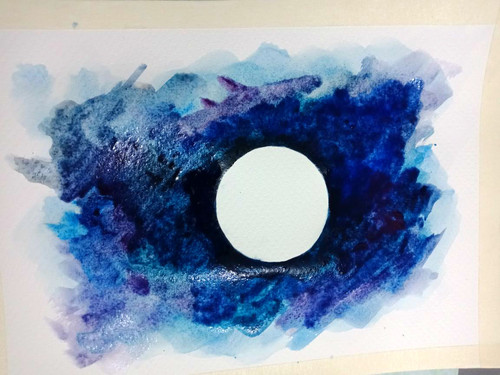Hello everyone!
.
Have you ever wondered if watercolor is hard or easy? Personally speaking, I would say that it's not easy, but it shouldn't be hard either.
.
When it comes to watercolor painting, various techniques take forever to master as you incorporate them into your painting piece. There are several reasons why it's hard yet getting more interesting as you study them further. For instance, as a water-based medium, it could give you a bit of frustration due it's unpredictable touch. It's true however that it's inevitable to chase the water paints while still wet, but that's the exciting experience of what the watercolor medium offers. Moreover, the paper and pigment's choice may also affect your painting practice in general.
.
Let's check this easy full moon painting. As you can see, we leave a white circle spot (for the moon) and start painting the background using the "wet on wet technique." We overlay the wet paint over the underpaint (the base wash of paint) that's also wet. Although painted with the new layer, it still naturally reveals the underlayers of pigments with a subtle blending of the new one.


.
.
As for the color, it plays an essential role in bringing out the vibrant beauty of your painting. A wrong color choice may affect your entire concept and painting goals. For example, overdoing the "wet on wet technique" may lead to a muddied work. So you better wait for a quite while before overlaying it with another pigment. Furthermore, color defines the excellent value of shadow and highlights. Nevertheless, planning it out beforehand is the key to achieving your preferred painting style and effects.
.
For my pigments, I'm using the beginner-friendly Reeves watercolor:
1. Ultramarine Blue
2. Phtalo Blue
3. Payne's Gray (that gives me the dark touch)
4. Crimson red (that naturally blends with the blue pigments and creates a bit of red-purple)

.
.
Patience is another key to thrive in your watercolor painting. You need to patiently wait for several layers of pigments until it dries before you take the next action. If you can't see the shiny parts anymore, they're probably dry and ready for more painting adjustments.

.
.
Right then, you can determine if you'll be adding some more layers or you'll be working on the moon's texture effects instead. Afterward, you can mock it up with a few "splattering technique" (for the stars) and see if you're already pleased with the outcome. Don't worry if the wet paints are too vibrant as it'll fade naturally when it dries.

.
.
If you're still unsatisfied with the overall look, you can always re-do it and carefully add new layers when needed (just like how I wanted to achieve a darker value of the night sky.) Otherwise, there are various techniques that you can use if you've accidentally painted the supposedly white spots for the highlight. Not to mention, we couldn't deny that watercolor is unforgiving at times especially when you wish to erase some parts. In this matter, your paper quality plays a vital role in covering up your rendering mistakes. Try to pull up paints on the accidentally painted area with water and damp it with the tissue paper (an erasing method). It might be a little challenging however if the paper's weight is less than 300gsm. Another way is through a mixed media of opaque pigments such as "white" gouache or acrylic paints. Merely overlay it on the dry area for highlighting purposes. Nonetheless, it'd be better if you try to make a habit of leaving the white spots for highlighting.

.
.
.Let it dry and prepare it for the final touch ups of "splattering technique" for the stars. Dip your brush to a bit pigmented white gouache paint and carefully tap it to another brush and splatters a good amount of stars around.


.
.
Now, here's our easy full moon watercolor painting! For the advanced students, perhaps artists, you can explore a more advanced techniques than these. And for the total beginner and the intermediate ones, does it still sound hard to you? It's doable, isn't it? Why not start creating your watercolor experience soon? I'd love to hear your artsy thoughts so please feel free to write down your commnets and inquiries below. :)

.
Paint with Jaja and learn more painting techniques and art theories in my class. See you around! All the best!
-------------------------------
Lesson: Watercolor Painting Class
Price: 2500 Points
Length: 50
Trial Minutes: 30
URL: http://cafetalk.com/lessons/detail/?id=57965
-------------------------------


 English
English 日本語
日本語 中文(简体)
中文(简体) 中文(繁體)
中文(繁體) 한국어
한국어 Italiano
Italiano español
español Deutsch
Deutsch Русский
Русский



